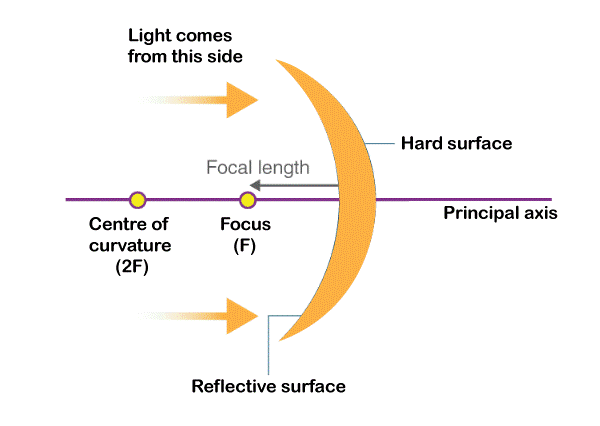Concave Mirror DefinitionA concave mirror is a spherical mirror where the reflecting surface curves inward like a spoon, and the centre of the reflecting surface becomes hollow towards the outside. Concave mirrors are also known as converging mirrors, as they converge or focus light rays to a point. They are used in various optical instruments, such as telescopes, microscopes, and headlights. 
Understanding the Basics of Concave MirrorThe reflecting surface of a concave mirror is called a concave spherical surface, and the sphere's center is called the mirror's pole (P). The line passing through the pole and the mirror's centre (C) of curvature is called the principal axis. The principal axis is the axis of symmetry of the mirror, and any ray of light that passes through the centre of curvature will be reflected along the same path. A concave mirror's focal point (F) is the point on the principal axis where all the parallel light rays converge after reflection. The distance between the focal point and the pole is called the focal length (f), and it determines the magnification and the size of the image formed by the mirror. The focal length is usually measured in meters. When a parallel ray of light falls on a concave mirror, it is reflected toward the focal point, the concave mirror's focal property. The distance between the object and the mirror is called the object distance (u), and the distance between the image and the mirror is called the image distance (v). The magnification (m) of the image is given by the ratio of the height of the image (h') to the size of the object (h), and so the formula becomes: M = -(v/u) = (h'/h) If the object is placed beyond the centre of curvature, the image is real, inverted, and diminished in size. However, if the object is set between the centre of curvature and the focal point, the image formed will be real, inverted, and magnified in size. Uses/ Applications of the Concave MirrorConcave mirrors have many practical applications in various fields, such as astronomy, medicine, and entertainment. Here are some of the most common uses of concave mirrors:
In conclusion, concave mirrors have many practical uses in various fields, ranging from astronomy and medicine to entertainment and energy production. They are used to collect, focus, and magnify light, making them essential tools in many different industries. Properties of Concave MirrorThe properties of a concave mirror can be explained using the laws of reflection, and the focal length determines the magnification and the size of the image formed by the mirror. Some notable properties of concave mirrors are as follows:
Image Formation by Concave MirrorWhen an object is placed at different places, the image formed by a concave mirror is also formed at different positions. Also, the size of the image and the nature of the image change accordingly. Take a look at the following table which shows where the images are formed when an object is placed in different positions:
Importance of Concave Mirror in Real LifeConcave mirrors play an important role in our daily lives and have many practical applications in various fields. Here are some of the most significant ways in which concave mirrors are essential in real life:
How is a Concave Mirror different from a Convex Mirror?Concave and convex mirrors are curved mirrors commonly used in optical devices such as telescopes, microscopes, and cameras. These mirrors are shaped to reflect light in a specific way, depending on their curvature and orientation. Some of the major differences between concave and convex mirrors based on various important aspects are as follows: ShapeThe most obvious difference between concave and convex mirrors is their shape. Concave mirrors are shaped like a bowl, with the reflective surface curving inward towards the focal point. Convex mirrors, on the other hand, are shaped like a dome, with the reflective surface curving outward away from the focal point. Image FormationConcave mirrors produce real and inverted images of objects when placed beyond the focal point. However, concave mirrors create virtual and upright images when an object is placed between the focal point and the mirror. Convex mirrors, on the other hand, always have virtual and upright images, regardless of where the object is placed. MagnificationConcave mirrors can produce magnified or reduced images of objects, depending on where the thing is placed relative to the focal point. However, convex mirrors always have a tendency to form diminished images of objects. Field of ViewConcave mirrors have the least field of view. In contrast, convex mirrors have a wider field of view than concave mirrors, making them useful in applications such as car mirrors and security mirrors. In summary, concave and convex mirrors differ in shape, image formation, magnification, field of view, and focal length. Understanding the properties of these mirrors can help engineers and scientists design and optimize optical systems for various applications.
Next TopicDefinition Of Done
|
 For Videos Join Our Youtube Channel: Join Now
For Videos Join Our Youtube Channel: Join Now
Feedback
- Send your Feedback to [email protected]
Help Others, Please Share










